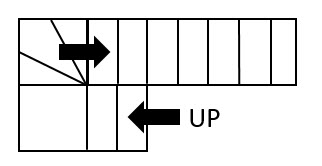


With the stair gauge, you are able to mark the first notch, then move the square so that the gauge aligns with the edge of the first notch and that puts the square exactly into place for the next notch. Mark the rise on one side of the square, the tread width on the other. Use a carpenter’s square with a carpenter’s square that has a stair gauge attached. You need at least two stringers for each section of staircase, but using more is perfectly acceptable, especially for wide steps. Since you know the rise and the tread size, you are ready to cut the stringers that hold up the stairs. Step 4 – Build the LandingĬreate a square or rectangular box that is 42.48 inches off of the floor, including the subfloor or decking surface. This means my landing needs to have a height of six risers, or (6 x 7.08), which equals 42.48 inches. Since we have 12 stairs on this sample staircase, we will divide them in half and have six before the landing and six after. It will need to be at exactly the height of one of the stairs. Now that you know exactly how much rise each step will have, you can calculate the height of the landing. Check building code in your area, since stairs are highly regulated. They can be larger, but should not be smaller under any condition. This fits two 2 x 6 pieces if you are using decking boards. Since the number was rounded slightly, you will need to divide 85 by 12 to get the exact height of each riser, which is 7.08 inches.Ī standard tread size is 10 inches. The standard rise on steps is seven inches, so normally the total rise is divided by seven (12.1), so you know that the steps will require 12 risers. Next you will decide how many standard steps will be needed to cover that distance. Step 2 – Calculate the Number of Steps and the Tread


 0 kommentar(er)
0 kommentar(er)
